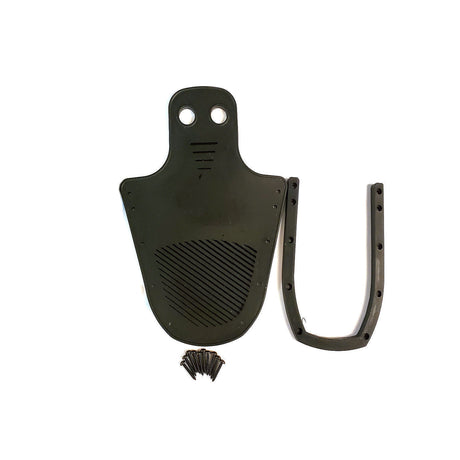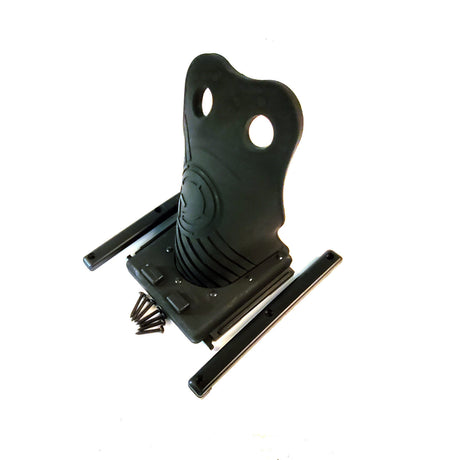Before you master paddleboarding (learn the basics here), you're going to need a board. There are two types of boards to pick from: Inflatables and solid boards. Both have pros and cons that the other can't provide -- so, which is better? And why? Let's compare.
Inflatable Paddleboards (iSUP): What Are They Made Of?

Inflatable boards are made from heavy-duty PVC outer shell with a drop-stitched core consisting of multi-directional polyester threads. In other words, they're made from composite fabrics.
To provide a soft, comfortable surface upon which to sit, stand, and do yoga, the PVC shell's top is covered with EVA, a soft, rubber-like compound.
Inflatable Paddleboard Pros
They're strong. The materials they're made from are highly resistant to abrasion, saltwater, and UV rays. An inflatable paddleboard will last years with regular use. Many SUP riders acknowledge that inflatables can, in fact, be more durable than solid boards. These boards can be ran over rocks, through shallow rivers laden with debris, and over any rough terrain with little risk of punctures and tears.
They're lightweight. These boards are far lighter than solid boards, which makes carrying and transporting them easy.
They're easy to store. When deflated, inflatable boards can be rolled up and stowed easily in a garage cabinet or closet, taking up little space. They're small enough to be carried in a pack, and will fit in the trunk of any vehicle.
They're great for whitewater. You wouldn't think of paddleboarding as an extreme sport, but it can be. Some SUP riders take their inflatables through whitewater rapids. The buoyancy, strength, and light weight of the inflatable board makes it well suited for rough waters.
They're more affordable. Inflatables are the most affordable type of SUP board. Solid boards are more expensive; it simply takes more time and materials to make them.
Inflatable Paddleboard Cons
They're not as stable. Inflatable boards sit higher in the water than solid paddleboards. This high center of gravity, caused by buoyancy, sacrifices some stability. Because inflatables aren't as rigid as solid boards, they also introduce a bit of flex when ridden. Because inflatable SUPs are light and physically larger than solid boards, they can be affected by wind and currents more easily, too.
They take time to inflate and deflate. With an electric pump, it'll take about 10 minutes to inflate your board. It takes about that long to fully deflate it, too. That doesn't sound like a long time. But if you ride often, especially daily, that time begins to add up. With a hand pump, it'll take longer to inflate -- about 15 to 20 minutes.
Types of Solid Paddleboards

The very first paddleboards were simply hollowed out, wooden surfboards -- but these were delicate constructions that simply couldn't withstand anything beyond calm water.
Today, solid paddleboards are made from much stronger materials, like bamboo, EVA, ABS, composites, and fiberglass. Regardless of their construction, these solid boards all provide the same advantages and disadvantages -- but before we get into that, let's compare the various construction methods.
Epoxy board
Epoxy boards are formed creating an EPS foam core, and wrapping it in layers of fiberglass with an epoxy resin coating. Several layers are woven over the core in all directions to provide strength and rigidity. Often, carbon fiber is used as a reinforcing material for rails and edges.
Soft-Top Board
Soft-top boards arent' so different from epoxy boards: They're formed from an EPS foam core, shaped and sized to the board's dimensions. But instead of being layered with hard-curing fiberglass, they're covered with a squishy, rubbery material called EVA (ethyl-vinyl acetate).
If you've ever stood on the rubber mats at your local gym, or felt the dense foam padding inside a music instrument case, you've encountered EVA.
This softer material absorbs impacts and abrasions well, while also providing a more comfortable surface for the rider. To further improve the board's strength, soft-top boards might have an ABS or polymer plate constructed on the bottom side to withstand scrapes and bumps.
Bamboo / Wood Board
Wood boards are still constructed with hollow shells, like the first paddleboards from decades ago -- except, like their fiberglass counterparts, these boards are filled with EPS foam cores and use layers of wood with curing resins to form stronger, lighter shells.
Solid Paddleboard Pros
They're responsive. Solid boards provide better control and performance than inflatable boards. They sit lower in the water, providing a better center of gravity, and their greater mass provides natural stability.
They're fast. Solid boards have slick hulls and polished surfaces, reducing drag in the water. Coupled with their higher stability and better tracking, solid boards can obtain greater speeds than inflatable boards.
They're not affected by wind. Solid SUPs are thinner and heavier. This extra density makes solid boards less susceptible with windy conditions, and they generally provide a better ride in choppy waters.
Solid Paddleboard Cons
They're heavy. Because solid boards are heavier, they're more difficult to handle and carry.
They're difficult to transport and store. Solid boards obviously can't be deflated and stuffed into a container or closet. They're more difficult to transport than an inflatable -- you'll need a roof rack or truckbed to transport a solid SUP, and you'll need more space at home to store your board.
They're expensive. Solid boards are usually costlier than inflatables.
They're not always strong. Soft-top and fiberglass boards can crack or break if they're ran over rough terrain or debris in the water. Wood and composite boards are stronger, but they can still suffer damage if abused, and no solid board will perform like an inflatable in whitewater rapids.
So, Which Board's Better?
For casual riders and beginners, an inflatable SUP is the better choice. They're more affordable, far easier to transport and store, and they're just as durable -- if not more rugged -- than the average solid board.
For riders who can handle the transportation and storage, and who want the most performance, speed, and control in the water, a solid board is the better choice.
We've made getting started easy! Check out out all-in-one standup paddleboard packages. They include a high-quality inflatable board, pump, and storage pack for transport.











